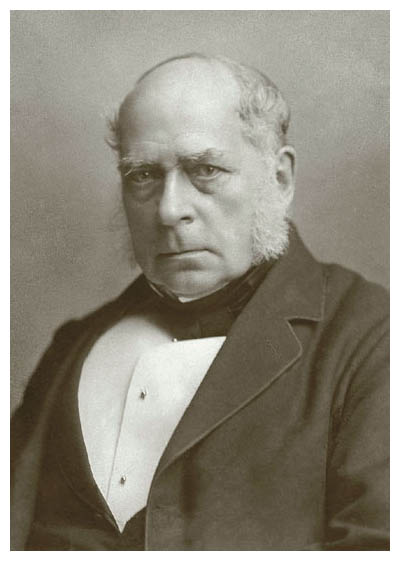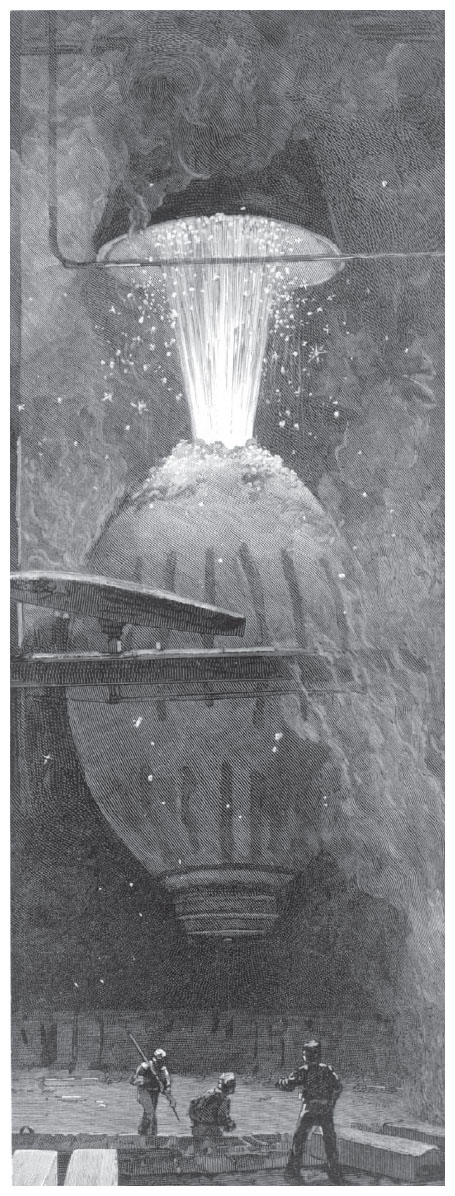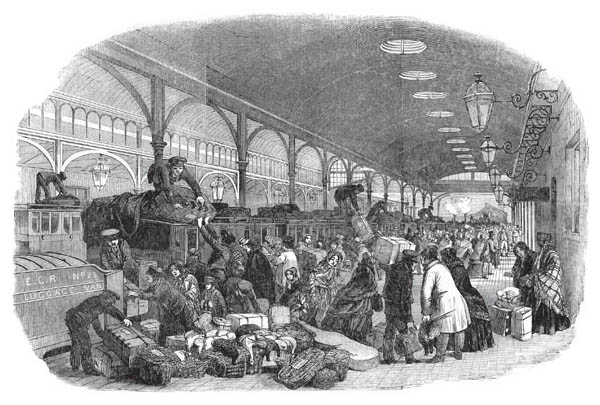Bessemer's Volcano and the Birth of Steel
By Ainissa Ramirez
Making this versatile metal plentiful gave rise to Christmas and an understanding of modern physics.
Making this versatile metal plentiful gave rise to Christmas and an understanding of modern physics.

DOI: 10.1511/2016.118.12
Henry Bessemer dreamed about steel. He longed to find a way to make an unlimited supply of it, and not knowing how wasn’t going to stop him.
Bessemer was a prolific 19th-century British inventor with more than 100 patents to his credit and a hunger to solve problems. Before his quest to make steel plentiful, his most famous invention was a gold-colored paint that contained no actual gold. In the 1840s, metallic paint was the must-have item in England for ornate picture frames. When he bought some of it for his sister’s art project, Bessemer was flabbergasted to learn that its cost was equal to a day’s wage. He created an inexpensive alternative by machining bronze into powder and adding it to paint; bronze glitters just as well at a fraction of the cost. This invention made him rich, but didn’t dampen his drive to innovate. Instead, Bessemer’s thoughts turned away from gold’s luster for decorations and toward steel’s toughness for weapons.

NYPL/Science Source
In 1853, England and its allies—France, Turkey, and Sardinia—were enmeshed in the conflict known now as the Crimean War, a battle to let Catholic pilgrims have access to the Holy Land in the Middle East. These allies supported the Catholics. The Russians, on the other side, wanted to keep the Holy Land for Orthodox Christians. To prevail in battle, England needed steel, and lots of it, for powerful cannons. But at the time, the process of converting raw iron into strong steel was painfully slow and expensive; it took a month to make just 50 pounds. In addition, only a few craftsmen knew the necessary techniques. The intense demand for a faster, cheaper way to make steel inspired many inventors, such as Bessemer, to develop a better process. They knew that the inventor who solved the problem would become very rich.
Bessemer’s path to becoming an inventor was plotted out from an early age by his father, Anthony Bessemer, a Londoner working in Paris. A respected inventor himself, Anthony was elected into the lauded French Academy of Sciences for his novel typesetting devices and improvements to the optical microscope. As a member of this esteemed society, his path crossed those of scientific elites such as Antoine Lavoisier, who named the element oxygen and is often called “the father of modern chemistry” for systematizing chemical names. However, Anthony’s charmed career came to an abrupt end with the French Revolution in 1792. Anthony barely escaped the guillotine, unlike Lavoisier, and hastily returned to England penniless. He settled in Charlton, England, a quiet town, rebuilt his typesetting workshop, and focused his energies on his son, Henry, born in 1813.
Bessemer's experiment went out of control, erupted violently, and burnt part of the building's roof. But after the fires died down, he found he was successful.
Henry Bessemer had very little formal education, but was allowed free rein in his father’s workshop. There he received tools instead of toys, and his desire to build was nurtured. The son matured into a tall and barrel-chested man, with a bold nose, meaty jowls, and thick sideburns that imperfectly camouflaged the lack of hair on the top of his head. Like many brilliant people, Bessemer was a study in contradiction: He was at times engaging, but at other times explosive. He was stubborn, but inspired by whimsy. He was generous, but overbearing. He was talkative in crowds, but preferred solitude with his machines. His physique embodied this paradox too: His chest was stout, but his legs were lanky.
Although Bessemer’s eyes looked preoccupied and sometimes sad, they were keen for seeing opportunities. In the 1850s, with his nation at war, his greatest moment had come: the mission of producing steel cheaply, rapidly, and abundantly.
Although steel is ubiquitous today—hidden in plain sight in skyscrapers, bridges, and even cutlery—most people don’t spend much time thinking about what goes into making it. Broadly speaking, steel is just iron with a bit of carbon in it. But that definition doesn’t capture the stunning metamorphosis that occurs when the iron and carbon merge in the correct way.
The secret behind steel is that it isn’t just one substance like most metals, but a mixture. On the microscopic scale, steel turns into two different substances that stack up like a layer cake. One of the layers is rich in carbon and strong. This layer is a chemical compound called cementite, and with the right amount of force, it snaps like brittle chalk. The other layer has little carbon (around 0.2 percent) and is malleable (flexible and easily bent). This chemical compound is called ferrite, and with enough force, it can be pulled like taffy. These layers complement each other with strength and malleability. Most metals, being monolithic, have only one property or the other. The characteristics of strength and malleability usually are more like two ends of a seesaw; as one goes up, the other goes down. But in steel, its layers allow both properties to exist, and that makes steel versatile and suitable to build many things, from trains to tools to cars to cans.

Astrid & Hanns-Frieder Michler/Science Source
Much of this detailed chemical knowledge was unknown when Bessemer started filing patents for making steel in the mid-1850s. The study of metals, known as metallurgy, was still in its infancy. One of the key figures who moved this discipline along was a British amateur geologist named Henry Clifton Sorby. He would take a piece of metal, polish it, and etch the surface with acid. Then he would look at the metal under his microscope. In 1863, during these experiments, Sorby saw the secret of steel: its alternating layers. These layers cannot be seen without etching the surface, which is why they had remained hidden until then. The insight came too late to help Bessemer in his process of discovery, but it proved useful later in defining what steel is.
Bessemer knew that creating good steel on a large scale wasn’t going to be easy. Adding the perfect amount of carbon into iron to get it just right was a page torn out of Goldilocks and the Three Bears: Too little carbon makes the steel too soft. Too much carbon, say more than 2 percent, causes steel to be brittle, making cannons that tend to explode. Steels with too much carbon would not withstand the impact of a cannon firing; the cannon itself would shatter into shards. A perfect steel for cannons needed an amount of no more than 1 percent of carbon within the iron, and this process of mixing carbon into molten steel to achieve this exact percentage needed to be done properly and repeatedly.

Library of Congress
The problem was even more complicated because pure iron was not the starting point. The metals that could be produced at the time were cast iron and wrought iron. Although their names have the word “iron” in them, they both were technically types of steel, composed of both iron and carbon. Unfortunately, these inferior steels had poor properties. Cast iron was steel with too much carbon in it, so it was brittle. Additionally, it could not be welded or forged into a cannon shape. On the other hand, wrought iron had very little carbon in it and so it was weak. Wrought iron was also full of unwanted filaments of other materials such as silicon, phosphorus, and sulfur. These impurities, known as slag, weakened the iron and jeopardized the cannon’s integrity.
Bessemer’s thinking was that useful steel could be made starting from wrought iron if he could figure out an efficient way to remove the impurities. He hoped to scoop them out of the molten metal, much as a chef would skim fat off the top of a simmering stock. Unfortunately for Bessemer, furnaces at the time could not sustain temperatures hot enough to melt a large vat of iron. He built his own custom furnace and made “many modifications and alterations,” as he stated in his autobiography, to get the right conditions, but none of them got the furnace hot enough to liquefy large amounts of iron and burn off the carbon.
Bessemer was like an unstoppable man of steel, but he also had his Kryptonite—the ocean. He was unusually prone to severe attacks of seasickness. “Few persons have suffered more severely than I have from seasickness,” he said in his autobiography. His bouts flattened him for days. (To mitigate his condition, he even devised a customized ship with a cabin that moved independently from the rest of the vessel, so it would be unaffected by the ship’s pitching and rolling, but unfortunately the ship crashed on its maiden voyage.) While convalescing in bed after a long ocean trip, the idea came to him: To burn off impurities in wrought iron and turn it into steel, he realized, all he needed was a lot of air, not a hotter furnace per se. He wrote in his autobiography, “I became convinced that if air could be brought into contact with a sufficiently extensive surface of molten crude iron, it would rapidly convert it into malleable iron.”
In 1855, Bessemer blew air directly into the molten metal bath from a pipe inserted from the top to burn off the carbon. The blown air incited a chemical reaction of oxygen and carbon that harkened to the behavior of a volcano. It was a crazy idea, but it worked.
He described his experiment in his autobiography: “All went on quietly for about ten minutes,” he said. Occasionally he would see sparks, but that did not alarm him as that was to be expected when forcing air into molten metal. He anticipated a bubbling cauldron with flames and smoke. A few minutes later it changed to fire and brimstone. The air violently reacted with the carbon in the vat of boiling metal and “sent up an ever-increasing stream of sparks and a voluminous white flame,” soon followed by a battery of loud explosions as the air and carbon chemically combined, thereby removing the carbon from the molten metal. This bubbling brew became Vesuvius.
Although Bessemer recorded the events in a mild, matter-of-fact way in his autobiography and papers, it is clear from his description that his experiment went out of control, erupted violently, and burnt part of the building’s roof. But after the fires died down, he found he was successful. The blast of air had raised the temperature as he intended, allowing the iron to melt. The air then burned off the impurities in the molten iron—including the carbon, which he then was able to add back in precise amounts.
After six years of perfecting his recipe (combining it with the innovations from other engineers such as Robert Mushet’s discovery that adding manganese allowed steel to be forged, and Sidney Thomas’ method for removing phosphorus and preventing steel from becoming brittle), Bessemer got his steel in mass production. The Crimean War was long over at this point, and military demand for steel had declined. But being a resilient entrepreneur, Bessemer adhered to his personal motto of “Onward Ever” and set his sights on a promising new market: the railroads.
Bessemer solved the riddle for making steel cheaply and abundantly, and ushered civilization into the age of steel. As steel became cheaper and more plentiful, the use of steel railroad tracks grew precipitously. The first set of carriages rode on iron rails, but these could last only two years with light use. Steel rails, however, could be used for an average of 18 years, so their demand grew as railroads spread. In 1840, there were 3,326 miles of railroad track in the United States. By 1860, there were 30,600 miles—more than enough to circle the globe at the equator. From 1880 through 1895, 80 percent of all steel came from the Bessemer process, and by 1900, there was enough steel rail to go around the world 10 times. With this spread, all corners of the nation were knitted together with a constant flow of people, products, mail, and information. Traveling from New York City to Washington, D.C., in the early 1800s took five days by stagecoach. By the mid-1800s, that journey took a day by train, and society experienced time-space compression: As the time of travel decreased, so did the significance of the distance traveled. In essence, the world shrank.
In 1840, there were 3,326 miles of railroad track in the United States. By 1860, there were 30,600 miles.
The world also became more vertical. Before steel, stone buildings could be no more than 10 stories high. Steel girders, along with the invention of the modern elevator, enabled skyscrapers, and the economy, to soar. Department stores soon sprouted within these edifices and served as the center point for commerce, with steel rails carrying both products and patrons to them. Because of these commercial consequences, steel had an unusual offspring: Christmas. Before cheap steel, in early 19th-century America, Christmas was a minor holiday. Afterward, it underwent a metamorphosis (like steel itself) and became commercialized to keep the economy going and the trains running on steel rails. The New York Times noted the “epidemic of giving and receiving presents” in 1890.
Steel also helped transform physics. Prior to the railroads, going 30 miles per hour was breathtakingly fast. These swift speeds provided a decoupling from terra firma and an inspiration for Einstein to think about time and space in a new way. When a passenger rides on a train, events appear differently than they do to stationary people. Each observer has a different frame of reference when perceiving the world. Einstein used the train’s frame of reference in his thought experiments. Generally, if a passenger threw a ball on a train, the speed of the ball would be its own speed plus that of the train. Einstein surmised, however, that this effect is not the case for light.
Unlike the thrown ball, a light beam shone on a train would not gain the speed of the train. Einstein postulated that the speed of light was always the same, whether a person was on the train or stationary. Using the constant speed of light as an anchor to comprehend the workings of nature, Einstein asserted that something had to change for his thought experiment to work. That something was the classical construct of time. Time is not fixed, he showed; it slows down as we move faster and faster. It dilates. Einstein’s notion of relativity ultimately emerged from a new world built around steel.

19th era 2/Alamy Stock Photo
Bessemer could not have predicted steel’s curious role in Christmas and its contribution to modern physics. He might not have imagined that engineers would still be working to improve steel today—to make it stronger so that cars can be lighter and more fuel-efficient (with the goal in the United States of achieving an average of 54.5 miles per gallon by 2025). But he well understood the basic truth that technology and society evolve along with each other. Bessemer was a creator of change, and so was his steel.
Click "American Scientist" to access home page
American Scientist Comments and Discussion
To discuss our articles or comment on them, please share them and tag American Scientist on social media platforms. Here are links to our profiles on Twitter, Facebook, and LinkedIn.
If we re-share your post, we will moderate comments/discussion following our comments policy.